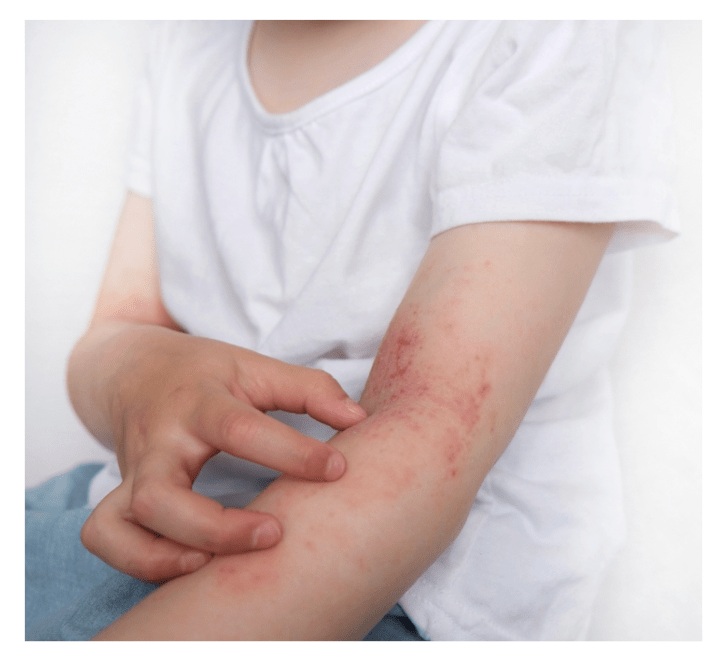Eczema In Children
Eczema is unbearably itchy – so much so that it is often known as the ‘itch that rashes’ rather than the ‘rash that itches’. This incessant itching inevitably leads to scratching, which increases the chance of infection resulting in even more itching and scratching. ScratchSleeves help to break the itch-scratch cycle by minimising the damage caused by scratching.
About Childhood Eczema
According to the National Eczema Society, signs that your baby has eczema include red and itchy patches of skin in babies with lighter skin and red or darker (hyperpigmented) patches of itchy skin in babies with darker skin.
As babies grow into children, the location and appearance of their eczema rash may change. Eczema in children and toddlers tends to settle into the folds of the skin: behind the knees, inside elbows, on the neck, hands, or around the eyes and ears. Darker skins can also be affected on the outer surfaces of knees and elbows. As children grow the rash typically becomes drier, with more flaking of the dry skin, and turns from red to brown-grey colour. In affected areas, your child’s skin inflammation can also become thickened and sensitive, especially if scratched regularly. These symptoms typically worsen and improve over time, with eczema flare-ups occurring periodically.
Eczema can also have a very real psychological effect on children. According to the National Eczema Association, some of the psychological problems that children with eczema commonly experience include sleep difficulties, irritability, low self-esteem, difficulty concentrating, and anxiety. A medical study into sleep disturbances in children with eczema also found that ‘children with atopic dermatitis often have disrupted sleep and daytime behavioural difficulties associated with insufficient sleep.’ In particular, the study found that children with eczema often experience difficulty falling asleep and frequent night waking.

It’s not just the child with eczema that can suffer mental health problems due to their condition either. Having a child with the condition can be stressful and upsetting, and can impact the wellbeing of the whole family. Unsurprisingly, an article on the National Eczema Association’s website about mental health and eczema found that childhood atopic dermatitis also has a significant impact on the emotional and social well-being of parents and caregivers.
Managing Childhood Eczema
One of the biggest problems with controlling childhood eczema is the intense urge to scratch at itchy skin, which may then bleed or become infected. These infections can further intensify the itching resulting in even more scratching. Scratching at night can also result in disturbed sleep, making children grumpy and irritable, they may also find it hard to concentrate and learn. Continued scratching can also result in skin thickening. This thickened skin loses flexibility and, as eczema tends to be worst around joints, painful cracks can develop as a result of natural movement.
The key to controlling the physical aspects of eczema is firstly a good maintenance routine which keeps the skin moist and supple, this minimises the risk of infection; and secondly identifying and avoiding flare-up triggers such as harsh detergents, pets, food allergies, heat, etc. By keeping the physical symptoms under control, the destructive secondary symptoms of disturbed sleep and low self-esteem can be minimised.
This means:
- Tracking down your child’s eczema triggers and finding ways to avoid or minimise them while maintaining as normal as possible family life
- Using moisturisers and emollients regularly and generously, not just during flare-ups;
- Keeping skin clean and undamaged to avoid infections, using scratch mitts when necessary.
- Providing constant reassurance to support your child’s self-esteem
How to Stop Kids Scratching
Apart from the immediate damage caused by scratching itchy eczema, scratching can also turn into a habit. To minimise the damage and stop this habit forming, you will need to give your child some effective strategies for dealing with the very real eczema itch. From experience, being told to ‘stop scratching’ without being told how is incredibly frustrating; but learning how not to scratch is an important life skill for an eczema sufferer.
The most effective way to stop young children scratching their eczema is by minimising the itching with a good skin maintenance routine and avoiding known triggers. Keeping rooms cool, dressing itchy kids in loose cotton clothing, and avoiding harsh soaps and detergents will also help. When these measures haven’t worked, a cold compress (or even an ice cube) can often be effective at stopping the itch; we keep a novelty gel-filled compress in the fridge for the purpose (which comes in handy for bumps and bruises as well). The American Academy of Dermatology Association recommends teaching kids and teenagers to lightly tap the skin near the itch with your fingers until it fades – the vibration created by the tapping interferes with the nerve signals responsible for the itch. On really itchy days (or nights), children’s Piriton allergy medicine can be helpful, but it will make them drowsy.
If the itch just won’t go away, distraction can be really effective – especially if it involves both hands. Watch your child and work out if there is a time when they are more likely to scratch. This will often be when they are tired, slightly bored in the car, or preoccupied watching the TV. Armed with this knowledge, you should be able to come up with a strategy to help them. Fiddly toys like Lego, tangle toys, and even a Rubik cube are great for keeping hands busy. We have found that character action figures are great at keeping our son’s hands out of mischief while he watches the TV. We also have some great games on our mobile phones to keep his scratchy fingers occupied when we are out and about.
A lot of kids scratch without being aware of it. In these cases, sticker charts are a great way to help young children become aware of when they are scratching. It also gives you a chance to reward your child for the major, but largely hidden, the achievement of stopping themselves from scratching. Our free printable reward chart and stickers include some useful guidance and top tips for helping kids to break the scratching habit before it becomes ingrained.
If scratching is inevitable, you’ll need to keep fingers nails clean and short to minimise the damage and risk of infection. It may also be necessary to cover the hands of young children who can’t stop themselves from scratching when their hands aren’t occupied or they are asleep. The unique double-layer mitts by ScratchSleeves minimise the damage caused by scratching, while the cool silk outer mitt is calming on the dry skin. The loose-fitting sleeve design ensures that the mitts not only stay but avoids any irritation of sore areas on hands and wrists that can occur when wearing other eczema gloves. See more on how ScratchSleeves work.
Eczema and Sleep
Children with eczema often find sleeping a problem because their inflamed skin can get hotter and itchier at night. Numerous medical studies have concluded that children with eczema experience sleep disturbances and poor quality sleep, including this 2019 study titled Association of Atopic Dermatitis With Sleep Quality in Children. It found that ‘atopic dermatitis appeared to negatively affect sleep quality throughout childhood, even among patients with mild and inactive disease. Increasing disease severity and comorbid asthma or allergic rhinitis appeared to be associated with worse sleep-quality outcomes.’ Poor sleep quality can affect a child’s mood and concentration the following day, especially during flare-ups. A bad night’s sleep does not set them up well for dealing with an itchy day. Here are some things that help our scratchy son to sleep well and wake up bouncing:
- Applying moisturiser before bedtime stories to allow it time to soak in
- Wearing loose-fitting, cotton nightwear – short-sleeved pyjamas and ScratchSleeves or ScratchSleeves PJs are a good place to start
- Keeping his bedroom cool and using a humidifier on nights when the central heating is on
- Using light cotton and natural-fibre bedding
- Keeping fluffy pets out of the bedroom, as they can make eczema worse
- Keeping house dust mites to a minimum by airing bedding daily, dusting with a damp cloth, machine washing soft toys regularly and replacing his carpet with hard floors and machine washable rugs
More information
As you no doubt already know, this overview isn’t the half of it: visit the ScratchSleeves blog for more information on the day-to-day challenges of living with childhood eczema. When it comes scratch mitts and sleepwear, if you know what you want to help your child deal with their eczema but can’t find it, drop us a line and we’ll do our best to help.
- NHS choices and Patient.co.uk – more information on diagnosis and treatment
- NSGCCE – Nottingham Support Group for Carers of Children with Eczema: a fantastic resource focused on childhood eczema
- National Eczema Society – useful fact sheets and some great resources for helping children understand their skin in the Schools section
- Eczema Outreach Support – A family focussed charity for babies and children with eczema
Our Sources
National Eczema Society – Article on Babies and eczema
National Eczema Association – Article on Eczema and Mental Health in Children
National Eczema Association – Article on Mental Health and Eczema: Seeing the Unseen

Quick buy



